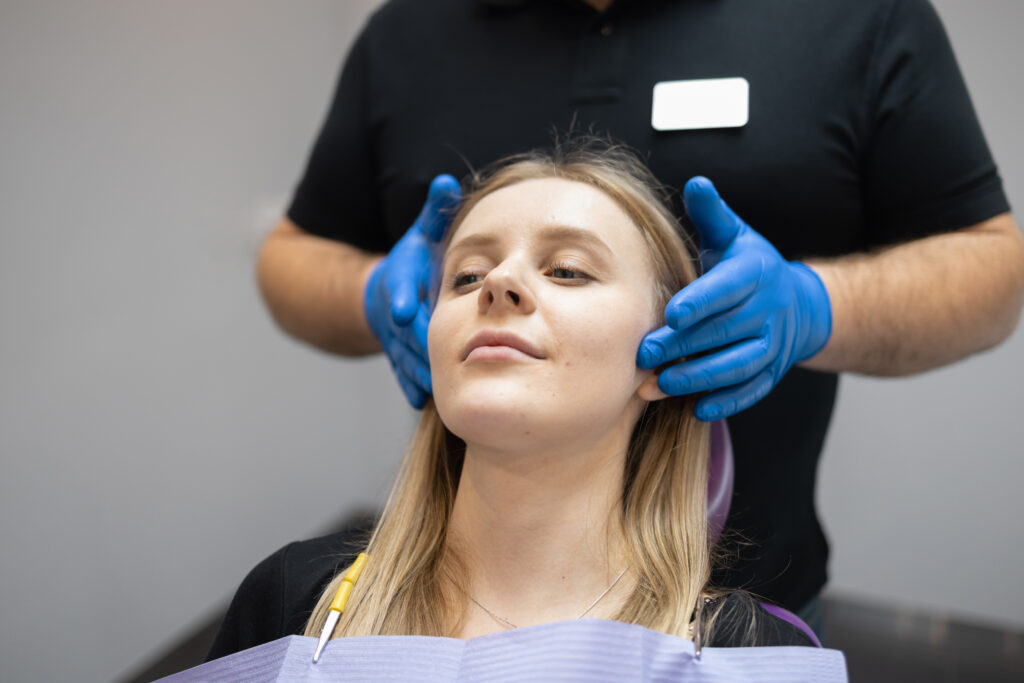What started as a minor pain in front of your ears has grown into a disturbing discomfort. The sight of crunchy food sends shivers down your spine, and talking or yawning has become an uphill task.
You might be suffering from temporomandibular joint dysfunction (TMD). The most severe of this disorder’s prevalence ranges from 5% to 12%.
The good news?
Your healthcare provider can help you identify its root cause and determine your case’s treatment option. Furthermore, various home remedies can help you spit this condition out of your mouth and life.
What are Temporomandibular Joints (TMJs)?
TMJs are joints that connect your mandible (lower jaw) to the skull’s base at the front of your ears. You have two TMJs joints (one at each side of your skull). Their parts include:
- Articular fossa: The joint’s socket
- Condyle: The mandible’s upper end. It’s usually round and movable
- Multiple facial muscles: They control your mandible’s movement when closing and opening your mouth
- Cartilage disk: It’s between the fossa and condyle. It cushions against stress and facilitates easy movement of the condyle.
- Ligament: Connects condyle to skull’s base.
These joints are bimodal, allowing translation gliding and hinge rotation.
What is a TMJ Dysfunction?
TMJ dysfunction happens when the joints don’t work effectively, leading to limited jaw opening. The result is difficulty in eating, talking, and yawning.
It also causes pain in the joints, facial muscles, and surrounding areas such as skull temples, cheekbones, neck, and ears. While the pain can be on both sides, it’s often one-sided.
TMJ Symptoms
The condition often leads to pain in your TMJ and the surrounding areas, especially when opening your mouth, eating, or yawning. So common TMJ symptoms include:
- Earaches
- Headaches
- Tinnitus
- Toothache
- Jaw clicking or popping
- Migraines
- Malocclusion (misfit in teeth arrangement)
- Pain in the neck, shoulders, and jaw
- Facial pain
- Stiffness in the jaw or difficulty opening the mouth
- Swelling around the affected region
Since patients are never the same, these symptoms can vary. But you must seek quick medical intervention to confirm and treat the disorder before it becomes severe.
Causes of TMJ Dysfunction
It’s often hard to pinpoint the specific root cause since every case is unique. But here are common causes:
- Severe bruxism: Bruxism happens due to grinding, gnashing, or clenching the teeth subconsciously (for example, when sleeping) or consciously (when you’re awake).
- Damage or dislocation of the cartilage disc: The shock-absorbing cartilage disc may get dislocated or damaged due to bruxism or other injuries. This leads to difficulties in smooth jaw movement.
- Connective tissue disorder: Damage to the connecting ligaments may affect the joint’s functioning
- Arthritis: Arthritis diseases may damage the cartilage lining. They include inflammatory, rheumatoid, or osteoarthritis.
- Stress: Sometimes, stress may be accompanied by teeth clenching or tightening of facial muscles. The resultant pressure may lead to TMJ dislocation and injuries.
- Malocclusion: It happens when the lower and upper teeth fail to fit well
Sure, some of the above factors are uncontrollable. But the following habits can put excess pressure on the facial muscles, TMJ, neck, and shoulder, worsening the TMJ condition:
- Using the teeth as a bottle opener or similar tools
- A nervous habit that involves chewing objects such as pens
- Poor posture that causes stress around the neck and facial muscles
- Conscious grinding of teeth during the daytime
- Taking a mouthful of food, overworking the facial muscles
- Chewing gum excessively
- Lying on your stomach
TMJ Diagnosis
Your doctor can pinpoint the underlying cause of your TMD condition in the following ways:
1. Health history
TMJ symptoms can mimic other medical problems such as gum diseases, arthritis, tooth decay, and sinus issues. Your dentist will inquire about your jaw pain history. They’ll also ask if your mouth produces popping or cracking sounds when opening it.
2. Physical examinations
Your TMJ dentist will examine your temporomandibular joints, jaw, and face. They will feel and gently press around these areas to pinpoint the exact region of discomfort and pain.
The healthcare personnel will ask you to open, close, and move your mandible sideways. They’ll observe this range of movement closely to see if your jaws work as they should or lock. They’ll also listen keenly for any grating, cracking or popping sound.
How far can you open your mouth? Your doctor will measure the mouth opening and observe any discomfort when you open and close your mouth.
The dentist may also ask you to take some bites (ranging in size). This test can easily reveal bite alignment and pain or discomfort if you have mandible or other jaw-related conditions.
It’s also crucial to examine your teeth. The doctor may check for evidence of irregular teeth surface, displaced teeth, high filings, and other teeth-related issues. Grinding or clenching your teeth can help them here.
Facial muscles and muscles around your neck, shoulder, and arm can also give more hints. So your dentist should be experienced enough to check them.
They may also liaise with other specialists to rule out or confirm other medical conditions. So you might be tested for ear disorders, nerve-related issues, headaches, infections, and other conditions.
3. Dental X-rays
There may be a need to observe invisible dental structures such as jawbones, sinuses, and nerves. That’s where digital or traditional dental X-rays (radiographs) come in to help your dentist dive deeper into a dental issue and understand its root cause.
Here, the dentist uses electromagnetic radiation to take your mouth’s photo. The beam penetrates your soft tissues to capture images of hidden structures such as jawbones and temporomandibular joints.
This procedure reveals issues such as TMJ dysfunctions, regions of infection, and loss of bones in your jaw. So they can help rule out or confirm other underlying conditions. And after treatment procedures, the dentist may use X-rays to observe how you’re progressing.
The following dental X-ray procedures are appropriate for temporomandibular joint disorder:
- Panoramic x-rays
Your dentist can use panoramic X-rays to capture certain components of your mouth, such as teeth, jaw joints, supporting bones, and nerves. It gives them an overview of your TMJ or other dental conditions.
- Cephalometric x-rays
This procedure allows the dentist to have a side view of your entire head. That way, they can see teeth location and jaw joints, allowing them to correct bites.
4. Computed Tomography (CT) Scan
While regular X-rays have helped solve teeth-related issues such as TMJ disorders, they often fail to reveal some structures. For instance, overlapping structures around the joint may hinder clear observation of the hidden parts. This limitation lies in the fact that regular X-rays only create flat 2D images.
CT scans come in to solve this issue. The CT machine will revolve around your head to take images of your jaw structures. It usually creates clearer, more precise, and detailed images of structures such as facial muscles, jaw bones, the temporomandibular joint, ligaments, and cartilage disc. Furthermore, your dentist can capture hundreds of images within a few minutes.
They’ll guide you to prepare for the CT scan. Some general guidelines include:
- Arrive as early as possible
- Avoid eating 4 hours before the procedure
- Take only clear liquids within 2 hours before the appointment
- Avoid wearing uncomfortable clothes and metal jewelry.
The dentist may inject a contrast agent to highlight your affected TMJ and the surrounding regions. You might also drink a substance such as barium swallow to enhance your structures’ visibility, facilitating better diagnosis.
Peeing flushes these contrast agents out within a day or two. Other preparation guidelines include:
- Blood test: This procedure helps ensure the agent is safe.
- Allergy medication: The contrast agent often has iodine. If you’re allergic to this substance, you’ll get antihistamine or steroid medication a few hours before the injection.
- Contrast solution: Follow your dentist’s direction when taking this solution.
- Diet restrictions: To avoid nausea from the contrast agent, take only clear liquids (such as water, soft drinks, and juices) four hours before your appointment.
While the whole procedure takes about 60 minutes, scanning takes less than 15 minutes- preparation gulps down a huge chunk of the time. Once your dentist confirms the images are OK, you can return home.
5. Magnetic Resonance Imaging (MRI)
MRI is another painless imaging technique that can help diagnose your TMJ disorder. It employs a computer, magnet, and radio waves to create detailed and clear images of your jawbones, head, or entire body.
MRI procedures don’t use any radiation. Therefore, they’re great for patients who require frequent imaging without exposure to harmful rays.
There are two types of MRI machines:
- Open bore MRI: In this machine, you enter the large space between two flat magnets- say goodbye to the claustrophobic feeling that comes with closed MRI. But open MRI images are less clear.
- Closed-bore MRI: Here, you enter inside a hollow tube of a magnet. While the narrower space might spike anxiety, the machine produces a top-quality image of your head or body. A sedative might help you relax.
The contrast agent (containing Gadolinium) alters surrounding water molecules’ magnetic properties to help create clearer images of infections, blood vessels, tissues, TMJ, and other surrounding organs.
6. TMJ arthroscopy
Your medical provider may also suggest arthroscopy to understand the issue in your TMJs structures. They use an arthroscope to view the organs without making large incisions.
This surgical procedure can help diagnose TMJ-related issues such as arthritis, jaw pains, and torn ligaments, tendons, or cartilage. It’s great if non-surgical procedures such as braces, medications, or splints don’t work.
You must prepare and follow your doctor’s guidelines. For instance, tell them if you have allergies, take certain medications, or use blood thinners.
TMJ Treatment
The right remedy for your case depends on the root cause and pain severity. Your healthcare provider may first use non-invasive options such as medications. If symptoms persist, surgical interventions can bring you much-needed relief.
1. Pain relievers
A TMJ disorder often causes mild, medium, or severe pains. So painkillers can offer relief from the pain.
You may use over-the-counter (OTC) drugs to ease pain from arthritis, headaches, migraines, toothaches, jaw ache, and other TMJ-related pains. OTC medications include:
- Acetaminophen: They dull your nervous system’s pain receptors, easing your pain.
- Nonsteroidal anti-inflammatory drugs (NSAIDs) reduce the generation of prostaglandins, which usually irritate nerve endings.
- Topical: Smear, spray, or patch the medication directly on the skin where you feel pain.
Is the pain too stubborn to disappear? Your doctor may prescribe drugs that offer stronger relief. Such prescription medications include:
- Anti-depressants: Anti-depressants such as tricyclics work on neurotransmitters to relieve you from chronic pain.
- Opioids: In rare cases (due to their addictive nature), your healthcare provider may suggest opioids such as fentanyl and codeine. These medications alter your brain’s perception of pain.
- Steroids: Like NSAIDs, these powerful anti-inflammatory medications stop the production of irritant chemicals. They’re great for severe pain from issues such as severe arthritis and back pain.
- Topical: Stronger topicals like lidocaine are great prescription drugs to apply on the area above the affected joint.
Your doctor may also recommend a combination of OTC plus prescription drugs for better treatment.
2. Nonsteroidal Anti-Inflammatory Drugs (NSAIDs)
Whenever those TMJ-related headaches, arthritis, and jaw pains act up, reaching for an NSAID might give you much-needed relief. These medications stop the generation of certain inflammation-causing body chemicals.
They’re excellent for dealing with pain that comes with arthritis and other conditions that slowly damage your tissues. The common types include:
- Aspirin
- Ibuprofen
- Naproxen sodium
If the above drugs’ brand names are expensive, you can choose the less expensive generic options. It’s also possible to get non-prescription strength, OTC NSAIDs.
3. Muscle relaxers
Muscle relaxers are great if you contend with teeth-grinding or clenching habits (maybe due to stress or subconsciously). These drugs are usually prescription-based in the US. They include:
- Carisoprodol
- Orphenadrine
- Metaxalone
- Chlorzoxazone
- Orphenadrine
Most of these drugs block pain signals to the brain or cause sedative effects. They come as injections, tablets, capsules, or solutions.
4. Anti-depressants
As we saw, stress and depression might lead to teeth clenching or tightening of facial muscles. Some people might even eat huge chunks of food due to stress. That’s why anti-depressants are great TMJ treatment options.
Anti-depressants can help treat various depression-related conditions, such as:
- Bulimia
- Bipolar depression
- Generalized anxiety disorder
- Social anxiety disorder etc
The lower the stress, the lower your teeth-clenching habits. And that’s how you can spit TMJ disorder out of your mouth.
But while anti-depressants help deal with symptoms of depression, you need to address the underlying causes. That’s why your doctor may recommend psychotherapy on top of them.
5. Mouth guard
Your doctor may also recommend mouthguard appliances to cover your teeth and prevent further damage to your jaw joints. While most fit over the upper teeth, you can get those for lower teeth.
So, when can a mouth guard help you prevent or alleviate pain from TMJ disorder? It’s useful if you:
- Clench or grind your teeth subconsciously
- Do risky games or activities such as biking
- Play football. Boxing and other contact games
Sports people can wear mouthguards for sports to prevent injuries when on the field. You’re looking for wins, not injuries. And if you have a habit of grinding or clenching your teeth, your doctor can recommend a suitable guard that you can wear anywhere, anytime.
6. Physical therapy

Physical exercises are powerful remedies to TMJ dysfunction. They can alleviate pain, boost TMJ mobility, and strengthen jaw muscles. While anyone can perform these exercises at home, seeking your doctor’s guidance is recommended. Here are common ones:
- Jaw relaxation
Set aside 2-5 minutes daily to do this amazing exercise. Gently place your tongue on your palate behind the upper incisors. Avoid clenching your teeth. Run your tongue’s tip backward as far as possible.
While your tongue is in that position, open your mouth comfortably. Maintain that posture for 5 seconds, then close the mouth.
Repeat the steps slowly and firmly for around six more times. A popping sound may escape your mouth when you open it fully.
- Goldfish exercise
Relax your tongue on your palate roof and place a finger at the TMJ’s spot. Place another finger on the chin. Open your mouth halfway (partial opening) or fully (full opening) and close it. You’ll feel a slight resistance.
Alternatively, place a finger on the TMJ. Then drop the mandibular halfway (or fully) and close your mouth. Repeat the exercise at least six times a day.
7. Trigger Point Injections (TPI)
Acute trauma or stress can cause muscle fibers around your TMJ to get stuck in a contracted state. The issue may result in painful knots and other problems such as tension headaches. Your doctor may employ dry TPIs or those with injection substances (such as botulinum toxin) to deal with these knots.
If your myofascial pain from the trigger points (knots) hasn’t responded to other treatments, TPIs might be the best option. The doctor might also use it alongside physical therapy to relieve your pain.
Has the intense pain prevented you from doing physical therapy? TPIs can alleviate the suffering, allowing you to proceed with the therapy.
Other non-surgical treatments for TMJ disorder include:
- Ultrasound therapy: Your medical provider will use sound waves to deliver heat into the TMJ and surrounding structures. It improves blood flow and relaxes your muscles.
- Transcutaneous electrical nerve stimulation (TENS): They can also employ low-voltage electrical current to achieve the relaxation
- Behavioral changes: Lifestyle change works magic in many conditions. Regarding TMJ disorder, habits such as improved posture and the right use of teeth help avoid or treat the condition.
8. Surgical TMJ Treatment
Sometimes, TMJ dysfunction requires surgical treatment. Here are the most common ones:
- Arthrocentesis (Joint Aspiration)
Reduction in synovial fluid can lead to cartilage inflammation due to frequent joint movement. An accumulation of fluid in the joint can cause swelling and pain, limiting your ability to open and close your mouth.
So the doctor may use arthrocentesis to discover the underlying causes of your joint soreness and relieve the pain. The procedure involves using a thin needle to eliminate fluid from your TMJ.
After that, they inject anti-inflammatory drugs such as corticosteroids into the TMJ to relieve the pain, inflammation, swelling, and stiffness. This medication can also slow the future accumulation of fluid in the TMJ.
Most patients who contend with tendonitis and arthritis find relief from this surgery. However, you might need to return for the same treatment in the future due to re-accumulation of fluids.
- TMJ Arthroscopy
TMJ arthroscopy is a procedure that involves opening a small hole in the skin covering the affected TMJ. They then insert a cannula (a narrow tube) through the incision into your TMJ.
They can insert an arthroscope (a device with a camera and light) through the cannula to observe your joint. Next, the doctor inserts tiny surgical tools through the cannula to perform specific surgeries, such as repositioning the cartilage disk or removing scar tissue.
Often, recovery time takes less than seven days since the procedure is less intrusive. Arthroscopy also helps the dentist to perform complex procedures like reshaping your joint and relieving your sore.
- Open-joint surgery
More severe cases may need open-joint surgery. They include:
- Excess tissue that prevents seamless TMJ movement
- Fusion of various tissues and structures (ankylosis)
- Inaccessibility of the joint area using arthroscopy
This surgery helps the dentist to conduct complex procedures such as removing excess tissues, dealing with bony growth, and repositioning the disc. Discectomy might be necessary if the disc is unrepairable. In case of bony growth or diseased bones, the surgeon may remove some of them.
While you’ll need more time to recover from this procedure, it has a higher success rate. In fact, it can boost the range of motion and alleviate pain by 61% and 71%, respectively.
9. Home remedies and practices
Minor TMD cases don’t require prescribed drugs, surgical procedures, and other advanced treatment options. Apart from exercises and OTC medication, here are other home remedies with significant effects:
- Avoid wide jaw motions
It helps to maintain a comfortable jaw position when opening your mouth to yawn, eat, sing, yell etc. So ensure your facial muscles stay relaxed and avoid opening your mouth beyond a comfortable size.
- Adopt the right posture.
A poor sitting posture can trigger jaw pains and other medical complications, especially if you usually sit for long periods. So always take frequent breaks from work and use a chair with back support.
If you’re a long-distance or frequent driver, ensure the seat is upright. Sitting upright is also important when reading or watching TV.
- Get enough high-quality sleep.
Sleep is crucial for your overall health. Lie on your back (instead of your stomach) and support the neck with a pillow. Avoid putting your hand on the jaws if your sleeping style is on your side.
- Avoid stress
Use techniques like yoga, meditation, gardening, and mindfulness to loosen up. Your muscles, too, will thank you for making them happy.
- Shed off bad habits gradually.
Some habits can worsen TMJ dysfunction. Some of the tendencies to take note include:
- Biting your nail
- Clenching your jaw muscles or teeth
- Holding your chin in your hands
Let’s face it- Shedding off these habits won’t happen in a day. Instead, visit your doctor to identify them and discuss how to overcome them gradually.
- Stay clear of certain foods and activities.
Some foods and activities are enemies to your condition since they force your jaws to move or open extremely. So stay away from:
- Hard foods
- Yelling or yawning
- Biting huge amounts of food
Also, avoid foods that prolong your chewing session, such as chewing gum.
FAQ
1. Is TMJ disorder preventable?
While you cannot avoid some risk factors of TMJ dysfunction, reducing your risk is possible. Behavioral and lifestyle changes are great ways to keep this issue at bay. They include the following:
- Wear a mouth guard when sleeping to prevent unconscious clenching or grinding
- Wear a sports mouth guard before playing contact sports
- Reduce stress through techniques such as mindfulness
- Be mindful of your sleeping posture
2. What should I expect if I suffer from TMJ disorder?
The effects of TMJ dysfunction range from mild to severe. You can recover quickly within a few days or weeks, sometimes even without medical intervention. But in severe cases, the condition can affect your life’s quality.
If you contend with recurring facial pain, jaw pain, and other TMJ-related symptoms, rush to the nearest physician. They’ll advise you on the best treatment option to arrest the issue.
3. How long does TMJ disorder last?
A mild TMJ dysfunction can last from 1-2 weeks and disappear on its own. But a chronic case may persist for months or years. Fortunately, the right treatment and behavioral changes can help you bid it farewell.
4. Is TMJ dysfunction curable?
Yes. The right medication, physiotherapy, surgeries, or other treatment options can help cure this condition. Your healthcare provider may also suggest combining these options for quicker results.
5. When should I see a dentist or physician?
Visit a qualified healthcare provider if you experience persistent TMJ symptoms such as jaw pains, migraines, facial muscle pain, and difficulty chewing or yawning. They can help identify your exact root cause and determine your case’s right course of action.
Bid Farewell to Your TMJ Disorder
Temporomandibular joint dysfunction is a common disease that can affect anyone. Its symptoms include jaw pain, toothache, tinnitus, earaches, and clicking. And the root causes range from stress to jaw injury, malocclusion, and bruxism. Fortunately, your healthcare provider can determine the right treatment option depending on your symptoms and causes.
Are you looking to kick this condition out of your life for good? The trick is to address its root cause instead of pruning off symptoms. TMJ Relax helps you to do so. You can now rely on this cutting-edge, non-invasive treatment to treat your TMJ disorder. Find a TMJ Relax provider near you to see if you’re the solution’s right candidate.



